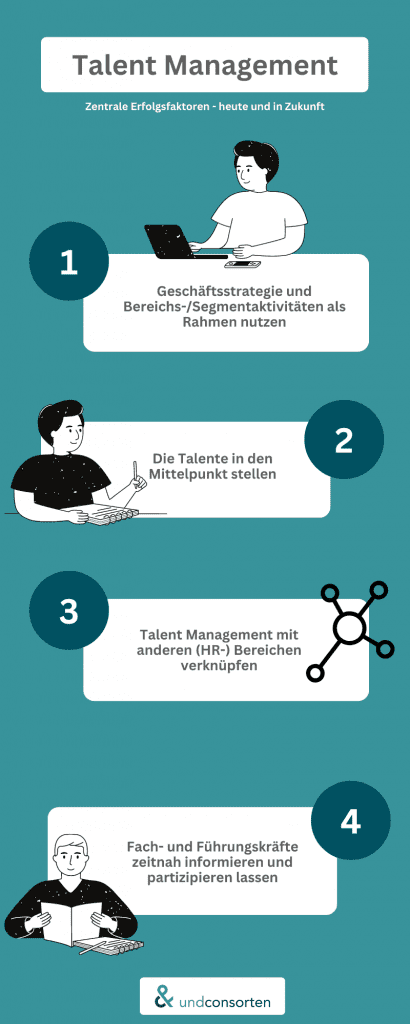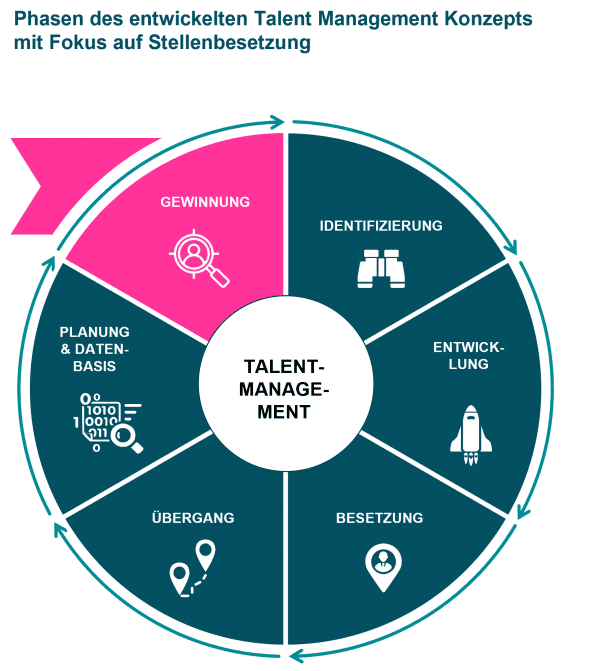
How to make your talent management fit for the future
At a time when skilled labour is desperately sought, talent management is of crucial importance. In this article, we shed light on the challenges facing HR professionals today. We also explain what needs to be considered in talent management in order to be prepared as a company for the demands of the future. In particular, we look at the role of big data and artificial intelligence (AI).
Simply explained: What is talent management?
Talent management refers to personnel policy and strategic measures for long-term talent development in companies and public institutions. The focus here is on filling critical positions for specialists and managers. The processes in talent management are based on the triad of "find, promote, retain" - along the talent lifecycle.
Challenges in the use of talent management
In recent years, many organisations have invested in talent management processes, tools and departments. However, most are often dissatisfied with the return on these investments, which is due to some typical challenges. A lot of effort is invested in identifying talent. However, this only results in transparency and, at best, a signal of appreciation. Specific development programmes are appreciated by talented people, but only develop their full potential when they move into new roles or take on new tasks. However, talent hiding, i.e. the withholding and concealment of talent by their direct managers, usually prevents critical positions from being optimally filled from an overall company perspective. The lack of talent mobility, unclear transition regulations or insufficient networking with other HR systems or processes such as skills management or recruiting are also often problematic. They make it difficult to transfer or transition people to the next role. Especially when the high performers of tomorrow have made it into the talent pool, but then lack attractive opportunities and prospects, frustration and demotivation are more likely to be generated. However, the shortage of skilled labour leaves companies no choice. They have to face up to these challenges. If you want to remain successful in the future, you have to act now. This includes breaking up outdated talent management structures and taking measures to retain talent in the long term.
The future of talent management
In future, talent management should be less about rigid identification processes and assessment criteria that give a small group of employees access to very specific programmes and offers. Instead, talent will be at the centre of all processes and offers in the future. The understanding of talent will become broader and more dynamic. Not least because future requirements can only be planned for the long term to a limited extent. The focus of companies is increasingly shifting from a position-orientation to an individual-orientation. Talent-centred development also means that employees are in the driving seat - HR and line managers are becoming co-pilots. The aim is therefore to offer talented employees guidance on what their possible next steps in the company could be. This combines a look at individual strengths and interests with needs on the company side. In order to increase the chances of taking the next step in their development, talents in the company must become even more visible across functional or departmental boundaries and network and exchange ideas internally. Attractive networking events at which managers explain strategic challenges in their areas or present future projects, for example, have proven to be a good way of doing this. Supplementary support for individual development helps to create positive experiences.
How big data and AI are changing talent management
Technology is crucial to efficiently enable more individualised talent management. Data-based identification of talent can replace time-consuming nomination and application processes. A willingness to learn or interest in change can be recognised automatically via activities on learning and job portals. In addition, numerous digital tools can support self-reflection - and result in recommendations for both development and job opportunities. Networking and socialising is possible at a low threshold. And in the future, AI will probably even be able to suggest talented individuals to managers who can strengthen existing teams. Talent-centred and data-driven action is also changing the role of the talent management department. It will have to spend less time on administrative tasks and can use the time gained to take on a more coaching and advisory role for talents and managers.
Success factors today and in the future
In addition to the use of technology, proven success factors should also be incorporated into the strategic conceptualisation of your own talent management:
- Business strategy and divisional/segment activities as a framework: To achieve impact, the business strategy and specific divisional/segment activities serve as a framework for all HR activities. They define the main objective to evaluate success and provide guidance for the talent management strategy.
- Putting talent at the centre: Successful talent management is based on a whole range of methods and processes. However, the key success factor lies in placing talent at the centre of all measures. This includes involving top performers directly in the development process of talent management systems, e.g. via focus groups. In this way, the right priorities are set and the offerings are implemented in line with the expectations of the talent - while at the same time strengthening their personal responsibility.
- Linking with other (HR) areas: To ensure the success of talent management and its acceptance among employees, it helps to build on existing offers and systems. For example, how can existing systems be used to develop talent into new roles? How can the talent pool be linked to an internal job market? And which existing benefits can be explicitly offered to talents (e.g. booking priority for popular training courses, participation in conferences)? Only if talent management is seen as part of the rest of the offering can it serve to develop and retain top performers sustainably and in the long term.
- Talent development starts in the mind: To ensure that phenomena such as talent hiding do not stand in the way of the success of talent management, it is first necessary to convince management, executives and relevant multipliers of the added value and benefits of strategic talent development from an overall company perspective. To do this, it is necessary to inform the responsible specialists and managers promptly and comprehensively about planned measures and to involve them in the identification and development process from the outset. In addition, positive examples within the company should be communicated quickly and widely. Ideally, also directly from the people involved themselves.

Practical example: the development of talent pools
A German insurance company asked us to support them as a sparring partner in the reorganisation of their existing talent management system.
- Step: Analysing the current situation and defining the target state In a combination of interviews with affected stakeholder groups (talents, specialist departments, managers) and comparative values from employees at other companies, both the current state of talent management and the vision for future talent management were developed. Based on the results obtained, we worked with our clients to define the objectives for talent management. We also developed a talent definition customised to the needs of the insurance company and derived overarching talent principles and the basic talent management concept (see Figure 2). The concept focuses on actively and successfully filling vacancies with the widest possible access to talent. The inclusion of temporary project positions is intended to break down perceived silos and reduce the risk of change. Hybrid working models have reduced the geographical barriers between the field and head office.
- In the next step, we trialled the conceptwith talent, management and specialist departments to check whether it met the various requirements and expectations of the relevant stakeholder groups. Based on this input, we further honed the talent management concept.
- Step 2: Planning and co-creative implementation of a pilot Before the actual rollout of the new talent management system, we piloted the project in the form of a project pool. Our aim was to use the knowledge gained from this to further optimise the concept before it went live. The development of the pilot was based on close co-creation between a specific area that provided relevant practical knowledge, the internal talent management experts and the talents themselves. By involving the latter directly and actively in the design process, we were able to take their requirements and needs into account in the best possible way during the pilot. As a result, a standardised system was developed that enables employees to find out about and apply for internal vacancies in a transparent and low-threshold manner, e.g. through project profiles. The fact that the talent management pilot was based on existing processes and systems such as the intranet or the internal job market was critical to its success.
- In order to ensure that every manager and every employee understands the principles and background of the new talent management system, close communication support is essential during the pilot phase and later during the introduction phase. For example, guidelines and checklists are developed and distributed to managers and project managers to clarify their respective roles in the new talent management process. Guidance on handing over current tasks to temporary deputies or familiarising talented employees with projects not only improves their learning experience and productivity. They also have a positive ripple effect on the organisation as a whole.
- Step: Overall rollout of the adapted talent management concept In an agile approach, the concept was honed with the help of the pilot results. For example, the requirements for suitable project roles and contexts, as well as operational challenges in terms of IT equipment or dealing with business trips, were concretised. This is followed by the rollout to the entire organisation. To ensure the successful continuation of the new talent management concept, clearly defined roles and processes must be used to ensure the maintenance and control of talent management. We also work with the insurance company to continuously sharpen the interfaces to communication and other HR topics. Based on analyses with monitoring tools, we can also make ongoing adjustments to the concept.

Develop your talent management further
We hope that our article on the talent management of the future has given you some interesting ideas for your work. We would be happy to support you and your company in scrutinising your current talent management processes, developing them successfully and making them fit for the future. Simply contact with us. We look forward to working with you to develop a solution for your specific challenges.




